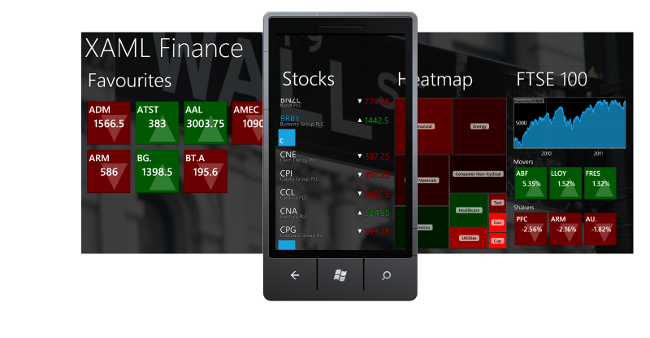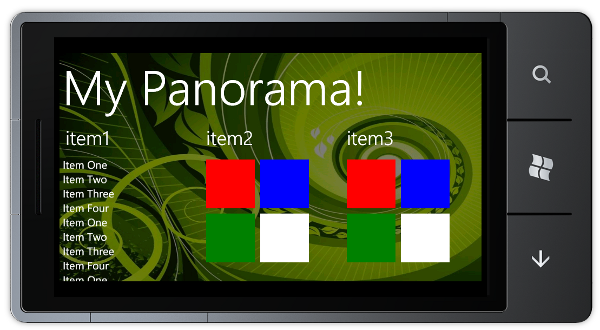The Windows Phone 7 Panorama control is widely used in applications and to many has come to symbolise the Metro Design Language. Search for panorama images and you will find numerous promo-shots of Windows Phone 7 applications which display the panoramic contents of the application hub, with an image of a phone above it illustrating how the panorama slides through your viewport.
The image below shows a promo-shot for XAMLFinance, an application I have been working on:

Creating images like the one above takes a bit of work, fortunately you can turn off the parallax scrolling effect of the control allowing for easier image stitching, however the process is still quite manual.
For a bit of fun I thought it would be nice to template the Panorama control itself in order to display the full panorama contents on the emulator within a single screen, so that I can create my promo-shot with a single screengrab.
Unfortunately, the Panorama control is a little too tightly coupled to its template to allow this kind of radical re-design, so the next best options is to create a new page that hosts my PanoramaItems within an ItemsControl and style that.
So, we'll start with a page which hosts our items within an ItemsControl:
<ItemsControl Style="{StaticResource ItemsControlStyle}">
<ItemsControl.Background>
<ImageBrush ImageSource="PanoramaBackground.jpg" Opacity="0.5"/>
</ItemsControl.Background>
<!--Panorama item one-->
<controls:PanoramaItem Header="item1" Style="{StaticResource PanoramaItemStyle}">
<Grid>
...
</Grid>
</controls:PanoramaItem>
<!--Panorama item two-->
<controls:PanoramaItem Header="item2" Style="{StaticResource PanoramaItemStyle}">
<Grid>
...
</Grid>
</controls:PanoramaItem>
<!--Panorama item three-->
<controls:PanoramaItem Header="item3" Style="{StaticResource PanoramaItemStyle}">
<Grid>
...
</Grid>
</controls:PanoramaItem>
</ItemsControl>We need to shrink each of those PanoramaItem instances so that they all fit on a single screen. We can easily shrink them with a ScaleTransform, however Silverlight only supports render transforms, what we really need here is a transform that affects layout also (for a brief overview of the difference see this blog post). Fortunately the Silverlight Toolkit has a LayoutTransformer class which emulates this behaviour, and whilst it is not available in the WP7 release, copying the code across I found it to be entirely compatible with the Silverlight WP7 version.
We can shrink our PanoramaItems as follows:
<system:Double x:Key="Scale">0.5</system:Double>
<Style x:Key="PanoramaItemStyle" TargetType="controls:PanoramaItem">
<Setter Property="Width" Value="260"/>
<Setter Property="Height" Value="290"/>
<Setter Property="Template">
<Setter.Value>
<ControlTemplate TargetType="controls:PanoramaItem">
<!-- apply a LayoutTransform to the content in order to scale it -->
<local:LayoutTransformer>
<local:LayoutTransformer.LayoutTransform>
<ScaleTransform ScaleX="{StaticResource Scale}"
ScaleY="{StaticResource Scale}"/>
</local:LayoutTransformer.LayoutTransform>
<!-- the original content of the template follows -->
<Grid Background="{TemplateBinding Background}" Margin="12,0,0,0">
<Grid.RowDefinitions>
<RowDefinition Height="auto"/>
<RowDefinition Height="*"/>
</Grid.RowDefinitions>
<ContentControl x:Name="header"
ContentTemplate="{TemplateBinding HeaderTemplate}"
Content="{TemplateBinding Header}"
FontSize="{StaticResource PhoneFontSizeExtraExtraLarge}"
FontFamily="{StaticResource PhoneFontFamilySemiLight}"
HorizontalAlignment="Left" Margin="10,-2,0,26">
<ContentControl.RenderTransform>
<TranslateTransform x:Name="headerTransform"/>
</ContentControl.RenderTransform>
</ContentControl>
<ContentPresenter Content="{TemplateBinding Content}"
HorizontalAlignment="{TemplateBinding HorizontalContentAlignment}"
Margin="{TemplateBinding Padding}" Grid.Row="1"
VerticalAlignment="{TemplateBinding VerticalContentAlignment}"/>
</Grid>
</local:LayoutTransformer>
</ControlTemplate>
</Setter.Value>
</Setter>
</Style>Now we need to styles and template the ItemsControl so that it looks like a Panorama. This is done as follows:
<Style TargetType="ItemsControl" x:Key="ItemsControlStyle">
<Setter Property="VerticalAlignment" Value="Center"/>
<Setter Property="HorizontalAlignment" Value="Center"/>
<Setter Property="ItemsPanel">
<Setter.Value>
<ItemsPanelTemplate>
<tk:WrapPanel Orientation="Horizontal"/>
</ItemsPanelTemplate>
</Setter.Value>
</Setter>
<Setter Property="Template">
<Setter.Value>
<!-- create a template for the ItemControl that makes it look like a panorama-->
<ControlTemplate>
<!-- the grid which displays the panorama background -->
<Grid Background="{TemplateBinding Background}">
<Grid.RowDefinitions>
<RowDefinition Height="auto"/>
<RowDefinition Height="*"/>
</Grid.RowDefinitions>
<!-- the title, scaled to match the PanoramatItems-->
<local:LayoutTransformer>
<local:LayoutTransformer.LayoutTransform>
<ScaleTransform ScaleX="{StaticResource Scale}"
ScaleY="{StaticResource Scale}"/>
</local:LayoutTransformer.LayoutTransform>
<TextBlock Text="{TemplateBinding Tag}"
FontSize="180"
FontFamily="{StaticResource PhoneFontFamilySemiLight}"
HorizontalAlignment="Left" Margin="10,-2,0,26"/>
</local:LayoutTransformer>
<!-- the rendered items -->
<ItemsPresenter Grid.Row="1"/>
</Grid>
</ControlTemplate>
</Setter.Value>
</Setter>
</Style>The end result is that we can see the entire panorama contents in a screen-shot ready state:
The big advantage of this approach is that any changes to the application can be reflected in the promo-shot very swiftly. It is also quite good fun having a fully functioning version of your panoramic hub in miniature!
You can download the sourcecode here: PanoramaShot.zip
Regards, Colin E.

